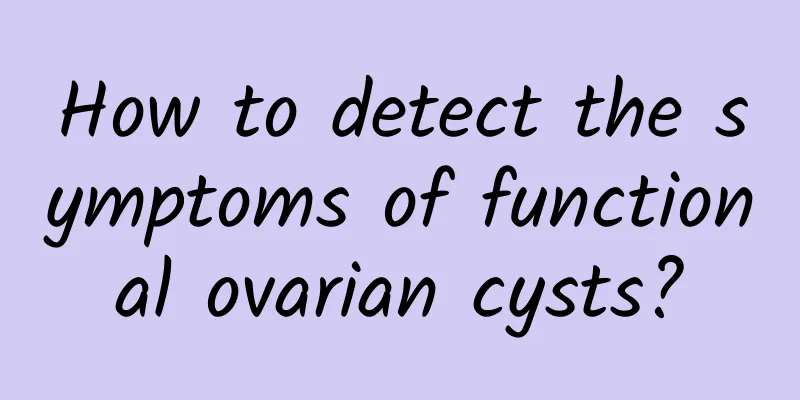How to detect the symptoms of functional ovarian cysts?

|
What are the symptoms of functional ovarian cysts? Is it easy to detect? 1. Functional ovarian cysts have no obvious clinical manifestations in the early stage, and patients are often found only during gynecological examinations when they seek medical treatment for other diseases. Later, as the tumor grows, the patient will feel it, and the symptoms and signs vary depending on the nature, size, development, and presence or absence of secondary degeneration or complications of the tumor. 2. Increased abdominal circumference and intra-abdominal masses are the most common phenomena in patients with functional ovarian cysts. After suffering from ovarian cysts, patients will feel discomfort in the lower abdomen and feel that the waist is thickening. Lower abdominal discomfort is the initial symptom before the patient touches the lower abdominal mass. Due to the weight of the tumor itself and the influence of intestinal peristalsis and changes in body position, the tumor moves in the pelvic cavity, involving its pedicle and pelvic funnel ligament, so that the patient has a feeling of distension and falling in the lower abdomen or iliac fossa. Increased abdominal circumference and intra-abdominal masses are the most common phenomena in the main complaints. Patients only notice the enlargement of their abdomen when they realize that their clothes or belts seem tight. 3. The pain caused by functional ovarian cysts may be continuous or dull. Malignant cysts often cause abdominal pain, leg pain, and pain, often requiring patients to seek emergency treatment. Usually, huge ovarian tumors can cause dyspnea and palpitations due to compression of the diaphragm. Ovarian tumors combined with a large amount of ascites can also cause ovarian cysts blocking the birth canal, causing such symptoms. However, the dyspnea of some ovarian tumor patients is caused by unilateral or bilateral pleural effusion. If the tumor has no complications, there is very little pain. Patients with ovarian tumors feel abdominal pain, especially those that occur suddenly, which is mostly caused by the twisting of the tumor pedicle, or occasionally by tumor rupture, bleeding or infection. Malignant cysts often cause abdominal pain and leg pain, and the pain often causes patients to seek emergency treatment. |
<<: What can I eat after laparoscopic surgery for uterine fibroids?
>>: Premonitions of miscarriage
Recommend
What can menopausal women with uterine fibroids eat?
Menopause is a period of major changes in a woman...
What are the dietary taboos for women with cervical erosion? Three aspects that patients with cervical erosion must know
What are the dietary taboos for cervical erosion?...
What should I pay attention to when I have adenomyosis?
The occurrence of adenomyosis is very harmful to ...
Don't confuse the symptoms of an enlarged cervix
Nowadays, many female friends ignore the symptoms...
Thread embedding for weight loss People with etiological obesity need to treat the disease first
Medical disputes over Chinese medicine thread emb...
Precautions for uterine effusion
What are the precautions for uterine effusion, wh...
Can an enlarged cervix infect family members?
Cervical hypertrophy is not contagious to family ...
How long will the pregnancy reaction last after abortion? 3 reasons why the pregnancy has not disappeared
How long it takes for pregnancy symptoms to disap...
What is the differential diagnosis of congenital absence of vagina?
In our lives, many people will have congenital ab...
Understanding what is threatened miscarriage
If you don't take care of your body when you ...
What are the causes of irregular menstruation?
What are the causes of irregular menstruation? Ir...
Paying attention to the cause of vaginitis can help women prevent this disease
The occurrence of vaginitis will have a serious i...
Successful pregnancy with Bartholinitis
Nowadays, Bartholinitis has gradually become a co...
4 common causes of amenorrhea
Amenorrhea is a female disease with a relatively ...
What are the common symptoms of adnexitis?
Before treating adnexitis, we must be clear that ...









